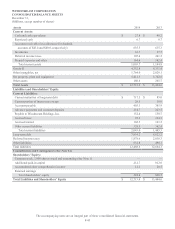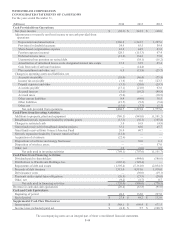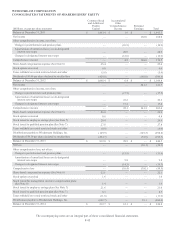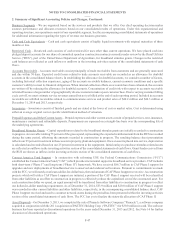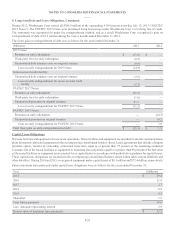Windstream 2014 Annual Report Download - page 168
Download and view the complete annual report
Please find page 168 of the 2014 Windstream annual report below. You can navigate through the pages in the report by either clicking on the pages listed below, or by using the keyword search tool below to find specific information within the annual report.
NOTES TO CONSOLIDATED FINANCIAL STATEMENTS
____
F-52
2. Summary of Significant Accounting Policies and Changes, Continued:
In 2014, the potential dilutive effect of 0.2 million shares of stock options were excluded from the computation of diluted weighted
average shares outstanding as the shares would have an anti-dilutive effect on the loss from continuing operations. In addition,
options to purchase shares of stock issuable under stock-based compensation plans that were excluded from the computation of
diluted earnings per share because the exercise prices were greater than the average market price of our common stock and,
therefore, the effect would be anti-dilutive, totaled approximately 0.6 million shares for the year ended December 31, 2014 and
1.0 million shares for each of the years ended December 31, 2013 and 2012, respectively.
Change in Accounting Estimate
The calculation of depreciation and amortization expense is based on the estimated economic useful lives of the underlying property,
plant and equipment and finite-lived intangible assets. We periodically obtain updated depreciation studies to evaluate whether
certain useful lives remain appropriate in accordance with authoritative guidance. With the assistance of outside expertise, we
completed analyses of the depreciable lives of assets held for certain subsidiaries during the year 2012. Based on those results,
we implemented new depreciation rates resulting in a net increase to depreciation of $59.1 million and a net decrease in net income
of $36.5 million or $0.06 per share for the year ended December 31, 2012.
Recently Adopted Accounting Standards
Discontinued Operations – In April 2014, the FASB issued revised guidance to reduce diversity in practice for reporting
discontinued operations. Under the previous guidance, any component of an entity that was a reportable segment, an operating
segment, a reporting unit, a subsidiary, or an asset group was eligible for discontinued operations presentation. The revised guidance
only allows disposals of components of an entity that represent a strategic shift (e.g., disposal of a major geographical area, a
major line of business, a major equity method investment, or other major parts of an entity) and that have a major effect on a
reporting entity’s operations and financial results to be reported as discontinued operations. The revised guidance also requires
expanded disclosure in the financial statements for discontinued operations as well as for disposals of significant components of
an entity that do not qualify for discontinued operations presentation. The updated guidance is effective for the fiscal years, and
interim periods within those years, beginning after December 15, 2014, with early adoption permitted. During the fourth quarter
of 2014, we early adopted this guidance, which did not affect our consolidated results of operations, financial position or liquidity.
Recently Issued Authoritative Guidance
Revenue Recognition – In May 2014, the Financial Accounting Standards Board (“FASB”) issued Accounting Standards Update
No. 2014-09, Revenue from Contracts with Customers (“ASU 2014-09”). The standard outlines a single comprehensive revenue
recognition model for entities to follow in accounting for revenue from contracts with customers and supersedes most current
revenue recognition guidance, including industry-specific guidance. The core principle of the revenue model is that an entity
should recognize revenue for the transfer of promised goods or services to customers in an amount that reflects the consideration
to which the entity expects to be entitled to receive for those goods or services. ASU 2014-09 also includes new accounting
principles related to the deferral and amortization of contract acquisition and fulfillment costs. ASU 2014-09 is effective for annual
periods beginning after December 15, 2016 and interim periods within those annual periods. Early adoption is not permitted. ASU
2014-09 may be adopted by applying the provisions of the new standard on a retrospective basis to all periods presented in the
financial statements or on a modified retrospective basis which would result in the recognition of a cumulative effect adjustment
in the year of adoption. We are in the process of determining the method of adoption and assessing the impact the new standard
will have on our consolidated financial statements.



